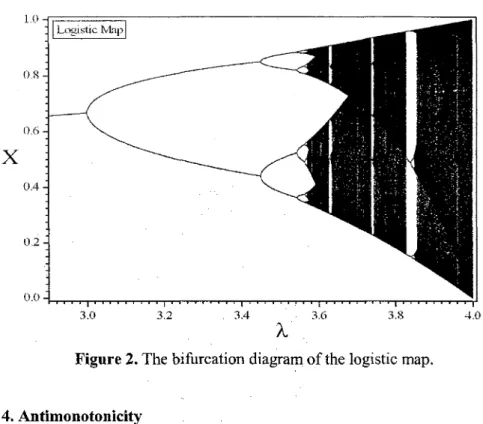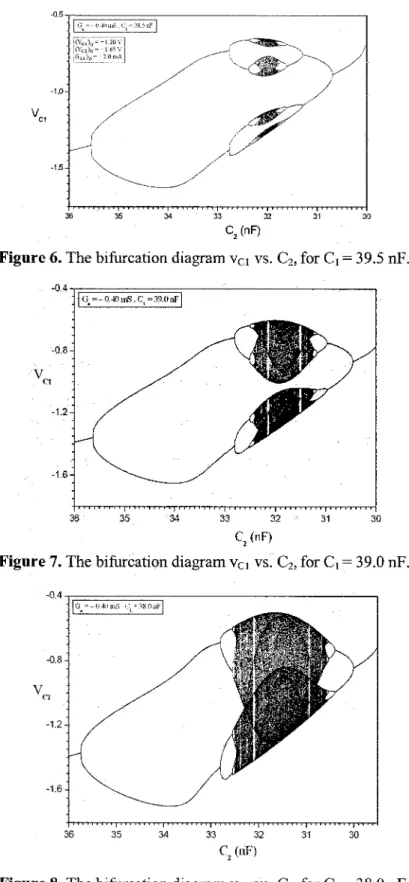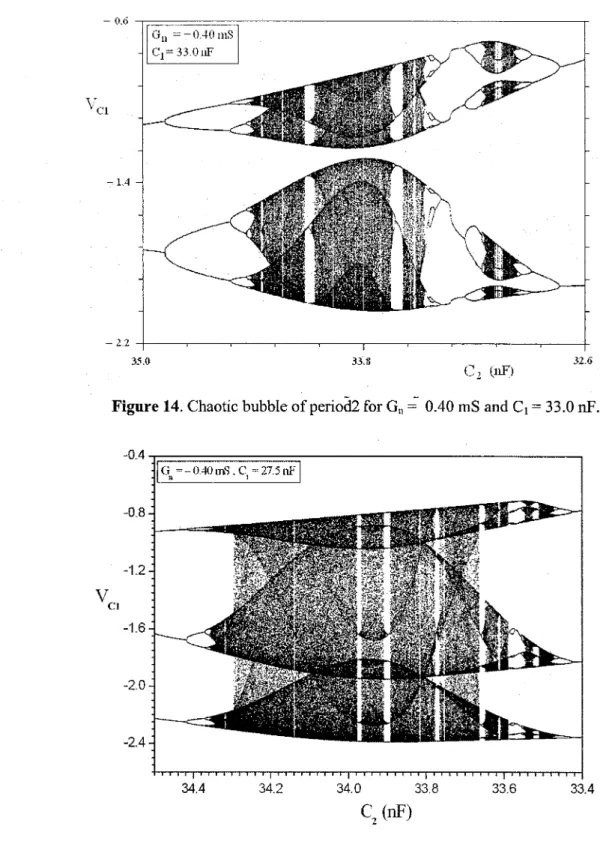Journal of istanbul Kültür University
2006/4 pp.65-76
REVERSE PERIOD DOUBLINGS IN A3Rl) ORDER NONLiNEAR AND
AUTONOMOUS ELECTRlC CIRCUIT
Ioannis M. KYPRIANIDiSi,Maria E.FOTIADOUi
Abstract
We have studied the dynamics of Chua's canonical circuit, when the v-i characteristic of the nonlinear resistor of the circuit is a smooth cubic function. Unlike the monotone bifurcation behavior of the members of Chua' s circuit family with a piecewise linear resistor, reverse period doublings, as a parameter of the circuit is varied in a monotone way, have been observed in the circuit we have studied. Dynamics of the circuit is very sensitive to initia\ conditions, as chaotic attractors coexist with period-l limit cycles.
Key-words: Nonlinear electric circuit, chaos, antimonotonicity, cubic nonlinearity, bubbles, crisis, coexisting attractors.
i.
IntroductionElectric circuits have emerged as a simp1e yet powerful experimental and analytical tool in studying chaotic behavior in nonlinear dynamics. Most chaotic and bifurcation effects cited in the literature have been observed in electric circuits e.g. the period-doubling route to chaos [1-4], intermittency route to chaos [5-8], quasiperiodicity route to chaos
[9-11], crisis [12-14], antimonotonicity [15, 16]. Chua's circuit is a paradigm for chaos [17].
Among the members of Chua's circuit family, the autonomous canonical Chua's circuit
introduced by Chua and Lin [18] is of considerable importance. This is because it is capable ofrealizing the behavior of every member of the Chua's circuit family [18,8, 14]. it consists of two active elements, one line ar negative conductor, and one nonlinear resistür with odd-symmetric piecewise linear u-i characteristic.
Later, some bifurcation phenomena were obtained for Chua's circuit with a smooth nonlinearity, in particular, cubic nonlinearity [19, 20]. The choice of a cubic nonlinearity has several advantages over a piecewise-linear one. it does not require absolute-valued functions
and it is smooth, which is desirable from a mathematical perspective. Moreover, all
phenomena found in the piecewise linear version also exist in the cubic version. 2. The Canonical Chua's Circuit
Chua's canonical circuit is a non1inear autonomous 3fd-order electric circuit (Figure la). The nonlinear element is a nonlinear resistor, while Gn is a linear negative conductance. in this paper, the v-i characteristic of the nonlinear resistür is a smooth cubic function, Figure
1b, of the form
loannis M. Kyprianidis. Maria E. Fotiadou
where ki, k3>O, instead of the piecewise linear type-N characteristic use d in the previous studies [8, 14, 18]. The 1aboratory realIzation ofthis nonlInear resistür can be found in [19].
L R
+. i +
V
Ci
(a) (b)
Figure 1. (a) Chua's canonica1 circuit, (b) the cubic v-i characteristic of the nonlinear resistor.
The state equations of the circuit are the following:
diL
1
dt
=L (-vci
+vC2 -RiL) (4)We have chosen the following values for the circuit parameters: L = 100 mR, R = 330 O, and Gn ~ 0.40 mS, while ki = 0.3 mS and k3 = 0.1 mAN3• Giving constant values to
capacitance Ci, we have plotted the bifurcation diagrams Vci vs. Cz. The comparative study of the bifurcation diagrams gives the qualitative changes of the dynamics of the system, as Ci takes different discrete values.
3. The Period - Doubling Route to Chaos
Cascades of period-doubling bifurcations have long been recognized to be one of the most common routes to chaos, as exemplified e.g. by the one-dimensional (ID) logistic map
Reverse Period Doublings in a3RDOrder Nonlinear and Autonomous Electric Circuit 10 -,iLogistic M'lpi o.s 0.6
x
0.4 02 0.0 3.0 32 3.4 3.6 3.8 4.0Figure 2. The bifurcation diagram of the logistic map.
4.Antimonotonicity
Unlike the monotone bifurcation behavior of the logistic map, however it has been
shown, that in many common nonlinear dynamical systems, periodic orbits can be both
created as well as destroyed, via reversebifurcation sequences as a parameter is varied in a monotone way. Dawson et aL., [21], named this type of creation and annihilation ofperiodic orbits antimonotonicity.
Reversals of period-doubling cascades have been observed in various nonlinear physical systems both numerically and experimentally. in one of the first studies of this phenomen~n [22], the occurrence of such reverse sequences was connected to the dynamics of a cubic ID map. As examples of numerical simulations, we cite the van der Pol equation [23], Duffing's oscillator [24], a RC-ladder chaos generator [25], and an autonomous 4th_ order nonlinear electric circuit [26]. Experimental manifestations of antimonotonicity have also been observed on the driven R, L,p-n junction nonlinear circuit [2, 27, 28], and on Chua's circuit, with an asymmetric v-i characteristic[29].
The general form of the bifurcation diagra!ll in the case of antimonotonicity, is shown in Figure 3. The system, starting from a periodN state, following the period doubling route enters the chaotic state. The system, as the control parameter "b" varies in a monot~ne way, leaves the chaotic regime via a reve!se period doubling cascade ending in periodN state. This configuration is known as "periodN bubble".
loannis M. Kyprianidis, Maria E. Foliadou
b
(controlparameter)
Figure 3. Thegeneral scheme of a period - 1 bubble.
in this paper, we have studied the dynamics of Chua's canonical circuit [18] with an
odd symmetric cubic nonlinearity and we have focused on the phenomenon of
antimonotonicity, which has never observed in the members of Chua's circuit family with a piecewise line ar symmetric i-v characteristic.
5. Period - 1 Bubbles
The bifurcation diagram Vei vs. Ci, for Ci = 41.0 nF is shown in-Figure 4. As Ciis decreased, the system always remains in a periodic state following the scheme: periodl -+ period2 -+periodl (or pl -+p2 -+pt). Bier and Bountis, [22], named this scheme "primary bubble". The bifurcation diagram Vei vs.
Ci,
for Ci = 40.0 nF is shown in Figure 5. The system remains again in a periodic state, but a period4 state is now formed.Reverse Period Doublings in a3RI> Order Nonlinear and Autonomous Electric Circuit -0,8 ' LG.. ,~ -OAO!US Ci 41.0l1F i -LO V O -1.2 -1.4 -1.6 1., .... ·'.. ···.,... 1 ••••••••• 1 36 3534 33 32 31 Ci(iiF)
Figure 4. The bifurcation diagram Vei vs. Ci,for Ci=41.0 nF.
-U5-r---~
, J~iG.-"--o-.j()-ii;<;-.',-CI-=40-_.o-iiF~i i -LU Vo
-1.5 1••••••••• 1 ••••• , ••• 1 ••••••• ,., ••••••••• 1 •••••.•••• 1 •••• '1 36 35 34 33 32 31 Ci(nF)Figure 5. The bifurcation diagram Vei vs. Ci,for Ci=40.0 nP.
As C2 is decreased, chaotic states appear, as we can observe in Figure 6, where the bifurcation diagram Vei vs. Ci, for Ci = 39.5 nF is shown. The bubble is now chaotic. Chaotic states become enlarged, as Ciis decreased (Figures 7-10). For all the bubbles, the
-
loannis M. Kyprianidis, Maria E. Foliadou
-05ji .. "," i
i'-LU-~-\lAIIiiiS.(.1 -_,9.)nI'i
1(\~;\F=-L20Vi(V';2)0"-1.65VI
·1.5
36 35 34 33 32 31 30
C2(nf)
Figure 6. The bifurcation diagram Vci vs, Cz, for Ci=39.5 nF. ·0.4 LG.=-OAOm.i;;'Ci=39.0 nfi ·0.8 V Cl -1.2 -1.6 36 35 34 33 32 31 30 Ci (nF)
Figure 7. The bifurcation diagram Vci vs.
Ci,
for Ci=39.0 nF. ·0.4 -0.8 V CI -1.2 -1.6 30 31 34 35 36 33 32 Ci(nF)Reverse Period Doublings in a3ROOrder Nonlinear and Autonomous Electric Circuit 00 i\;i •• "" ~04fJ mS, Ci=37(1OFi -0.5 V Cl -1.0 -1.5 -2.0 30 31 34 35 36 33 32 Ci (nF)
Figure 9. The bifurcation diagram Yci Ys. Cz,for Ci
=
37.0 nF.-0.4 -0.8 Vci -1.2 -1.6 ~ ~ ~ ~ ~ ~ W ~ Ci (nF)
Figure 10. The bifurcation diagram yci ys. Cz,for Ci
=
36.5 nF.1 ~1G~""_oÖAOm.~, Ct :"~36.0 nfi O vci -1 -2 36 35 34 33 Ci (nF) 32 31
loonnis M. Kypnonidis, Mono E. Fotiodou
Reverse period doublings are destroyed, when Ci =36,0 nF (Figure 11). A sudden transition, from a chaotic to a periodic state is observed at C2
=
31.0 nF, a phenomenon cal1ed crisis, [30]. in Figure 12, the chaotic spiral attractor (C2=3i
,onF) is shown, while in Figure 13 the periodic attractor (C2=30,8 nF) is shown.4 2 () V(2 -2 -4 -6 I, • • • i • .. i -2 () -4 Vu G.• =-0.40m.'S: Ci=36.0nF Ci=3L.0nF -i
Figure 12. Phase portrait for Ci=36.0 nF and C2=31.0 nF. Chaotic spiraI attractor.
o -2 -6 -4 .
,
() LG(i '"~-04<)mS36.0 ni' iC,'-308nF ~ -iFigure 13. Phase portrait for Ci=36.0 nF and C2=30.8 nF. Limit cycle.
6. Period -
N
BubblesFor Iower value s of Ci, bubbles of higher period are formed. in Figure 14, we can observe a chaotic bubb1e of period-2, while in Figure 15, a chaotic bubble of period-3 is shown. For Gn
=
0.45 mS and Ci=
40.0 nP, a period-S chaotic bubble is formed, as we can see in Figure 16.Reverse Period Doublings in a3RDOrder Nonlinear and Autonomous Eleetrie Cireuit - 0.6 Gn =-0.40111S Ci=33,0iiF -lA
- i..
2 35.0 33.8 Ci (iiF) 32.6Figure 14. Chaotic bubble ofperiod2 for Gn"; 0.40 mS and Ci
=
33.0 nP.-0.4 LG.=-0.40in'),c,=27.511Fi VCl -0.8 -1.2 -1.6 -2.0 -2.4 34.4 34.2 34.0 33.8
C (nP)
2 33.6 33.4 -loonnis M. Kyprionidis, Mario E. Fotiodou -0.6 -0,9 -1,2 -1,5 -1,8 -2,1 -2,4
LG..==O.451llS.Ci'-40.0nFI
40Jl 40.6
40,8 40A 40.2
Ci
(nF)Figure 16. Chaotic bubble ofperiod5 for Gn;; 0.45 mS and Ci
=
40.0 nP.7.Discussion and Conclusions
Bier and Bountis, [22], demonstrated that reverse period doubling sequences are expected to occur, when a minimum number of conditions is fulfilled. Their main result was, that areverse period doubling sequence is likely to occur in any nonlinear system, where there is a symmetry transformation, under which the state equation remains invariant.
Indeed OUT system of differential equations (2-4) under the transformation
remains invariant. in addition, it has also been demonstrated in the literature, [22, 31], that reverse period doubling commonly arises in nonlinear dynamical systems involving the variation of two parameters. it is important, however, that the period doubling "trees" develop symmetrically towards each other along some line in parameter space. This would
allow them to terminate, by joining their "branches" to form "bubbles", thus exhibiting the phenomenon of antimonotonicity.
We have to notice, that antimonotonicity is present, when the well-known "double-scroll" Chua's attractor, [32], is absent. This is an explanation, that antimonotonicity has not been observed in Chua's circuit with a piecewise linear resistor, although the former criteria
Rever.e Period Doubling. in a3RDOrder Nonlinear and Aulonomous Eleclric Circuil
References
[I] Linsay, P. S., (1981), "Period doub1ing and chaotic behavior in a driven anharmonic oscillator," Phys. Rev.
Lett., 47, 1349-1351.
[2] Van Buskirk, R. & Jeffries, c., (1985), "Observation of ehaotie dynamies of coup1ed non1inear oscillators," Phys. Rev. A, 31,3332-3357.
[3] Kennedy, M. P., (1993), "Three steps to chaos," IEEE Trans. Circuits Syst. - 1,40,640-674.
[4] Chua, L. O., Wu, c. W., Huang, A., & Zhong, G."Q., (1993) "A universal eireuit for studying and generating chaos," IEEE Trans. Circuits Syst. -I, 40, 732-761.
[5] Jeffries, C. & Perez, J., (1982), "Observation of a Pomeau- Manneville intermittent route to chaos in a nonlinear oscillator," Phys. Rev. A, 26, 2117-2122.
[6] Huang, 1. Y.&Kim, 1. 1., (1987), "Type - LIintermittency in a eoupled nonlinear oseillator: experimental observation," Phys. Rev. A, 36, 1495-1497.
[7] Fukushima, K. &Yamada, T., (1988), "Type - III intermitteney in a eoupled nonlinear LCR circuit," J
Phys. Soc.Japan, 57,4055-4062.
[8] Chua, L. O. &Lin, G. N., (1991), "lntermitteney in a pieeewise-linear cireuit," IEEE Trans. Circuits Syst., 38, 510-520.
[9] Matsumoto, T., Chua, L. O.&Tokunaga, R., (1987), "Chaos via torus breakdown," IEEE Trans. Circuits Syst., 34,240-253.
[lO] Chua, L. O., Yao, Y.&Yang, Q., (1986), "Devil's stairease route to ehaos in a nonlinear eireuit," Int. J
Circuit Theory Appl., 14,315-329.
[11] Petrani, M. L., Karakotsou, Ch., Kyprianidis, i.M. &Anagnostopou10s, A. N., (1994), "Charaeterization of the attraetor govemingthe neonbulb RC re1axation oseillator," Phys. Rev. E, 49,5863-5866.
[12] Jeffries, C. & Perez, 1., (1983), "Direct observation of crises of the ehaotic attraetor in a nonlinear oseillator," Phys. Rev. A, 27, 601-603.
[13] Ikezi, H., de Grassie, 1. S.&Jensen, T. H., (1983), "Observation ofmultiple-valued attractors and crises in a driven nonlinear cireuit," Phys. Rev. A, 28,1207-1209.
[14] Kyprianidis, i.M., Petrani, M. L., Kalomiros, J. A. & Anagnostopoulos, A. N., (1995), "Crisis-indueed intermittency in a third-order e1ectrical eireuit," Phys. Rev. E, 52, 2268-2273.
[15] Kocarev, Lj., Halle, K. S., Eckert, K. & Chua, L. O., (1993), "Experimental observation of antimonotonieity in Chua's eireuit," Chua's Circuit: A Paradigmfor Chaos, World Scientific, 137-144.
[16] Kyprianidis i.M., Stouboulos i.N., Haralabidis, P. &Bountis T., (2000), "Antimonotonieity and ehaotie dynamies in a fourthorder autonomous nonlInear eleetric eireuit," Int.J Bifurcation and Chaos, 10,
1903-1915.
[17] Madan, R. N., ed., (i 993), "Chua's Circuit: A Paradigmfor Chaos," World Scientific.
[18] Chua, L. O. &Lin, G. N., (1990), "Canonical realization ofChua's eircuit family," IEEE Trans. Circuits Syst., 37, 885-902.
[19] Zhong, G.-Q., (1994), "Implementation ofChua's eireuit with a eubie nonlinearity, IEEE Trans. Circuits Syst. - I, 4 I, 885-902.
[20] Huang, A., Pivka, L., Wu, c.-W., &Franz, M., (1996), "Chua's equation with eubie nonlinearity," Int. J Bifiircation and Chaos, 6, 2175-2222.
[21] Dawson, S. P., Grebogi, c., Yorke, J. A., Kan, i. & Koçak, H., (1992), "Antimonotonieity: inevitable reversals of period-doub1ing cascades," Phys. Lett. A, 162,249-254.
[22] Bier, M. &Bountis, T. c., (1984), "Remerging Feigenbaum trees in dynamieal systems," Phys.Lett A,
104, 239-244.
[23] Parlitz, U. &Lauterbom, W., (i 987), "Period-doubling easeades and devil's staireases of the driven van der Po1 oseillator," Phys. Rev. A, 36, 1428-1434.
[24] Parlitz, U.&Lauterborn, W., (1985), "Superstrueture in the bifureation set of the Duffing equation," Phys
Lett. A, 101,351-355.
loannis M. Kyprianidis, Maria E. Foliadou
[26] Kyprianidis, LM., Stouboulos, i. N., Haralabidis, P. and Bountis, T, (2000), "Antimonotonicity and chaotic dynamics in a 4th-order autonomous nonlinear electric circuit," Int. 1.Bijitreatian and Chaas, io,
1903-1915.
[27] Cascais,
l,
Dilao, R. &Noronha Da Costa, A., (1983), "Chaos and reverse bifurcation in a RCL circuit,"Phys.lett. A, 93, 213-216.
[28] Klinker, T,Meyer-Ilse, W. &Lauterbom, W., (1984), "Period doubling and chaotic behavior in a driven Toda oscillator," Phys. lett. A, ioi, 371-375.
[29] Kocarev, Lj., Halle, K. S., Eckert, K. & Chua, L. O., (1993), "Experimental observation of antimonotonicity in Chua's circuit," in Chua's Cireuit: A Paradigmfar Chaas, ed. Madan, R. N., World
Scientific, 137-144.
[30] Grebogi, C., Ott, E., &Yorke, J. A., (1983), "Crises, sudden changes in chaotic attractors, and transient chaos," Physiea D, 7, 181-200.
[31] Oppo, G. L.&Politi, A., (1984), "CoIlision of Feigenbaum cascades," Phys. Rev. A, 30,435-441.
[32] Chua, L. O., Komuro M., and Matsumoto, T, (1986), "The double scroll family: Parts








